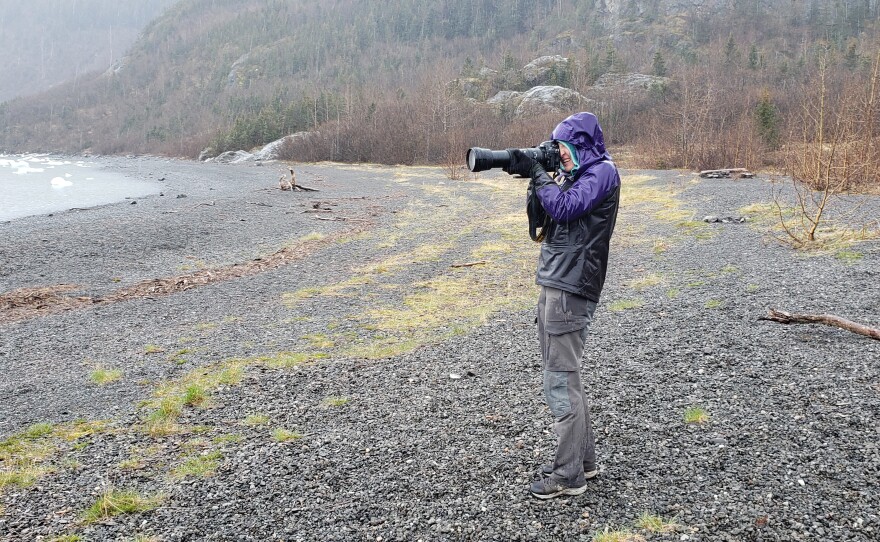Beginning birders meander through a seminar room full of stations with bird facts and activities. Dubbed the “Discovery Lab,” it intends to teach people the basics of birding. While the lab was originally designed for children, or Junior Birders, adults get a quieter opportunity to learn more about birding before hitting the field.
Kachemak Bay National Estuarine Research Reserve education coordinator Ingrid Harrald leads a simulation that teaches people how to do bird counts.
“What you can do is just look at what does a group of five looks like and then just be like, five, five, five, five…” She explained.
Edward Clennett and Alice Turner were two patrons who initially got drastically different numbers. Then they tried Herrald’s trick and both counted 290 birds, which Herrald said surprised her.
“The actual number was 277. You were within 4%,” she said.
Lora Haller is the manager for the Alaska Maritime National Wildlife Refuge Visitor Center in Homer. The center hosted the discovery lab, as well as numerous lectures throughout the festival. She said the keynote species for this year’s Kachemak Bay Annual Shorebird Festival was the red-necked phalarope.
“Folks are getting to learn all about the red-necked phalarope and how the female is more colorful than the male, and all their cool feeding habits where they spin in a circle to bring up plankton and other little insects and invertebrates to eat,” she said.
Haller said she was happy with the turnout this year.
“Going post COVID, we never know how many people are going to show up and come out for it,” she said, “but this year has been a really great year.”

Birders set out to explore the Beluga Slough Wetlands, right next to the visitor center, to see where migratory seabirds were resting.
There are also a lot of sandhill cranes that nest in Homer, and several stay in the wetland in the summer. One decided to show off, to the delight of birders.
Teen birders complete albatross dissection
Teens 15 and older were also able to participate in the Teen Birder program run by the Kachemak Bay National Estuarine Research Reserve. One of their activities included dissecting a Laysan albatross provided by the U.S. Fish and Wildlife Service.
Harrald, who led the bird counting activity, also introduced the dissection, talking about research into plastic found in albatrosses' stomachs. As she spoke, attendees passed around a bag containing golf balls, lighters and small plastic pieces found in a single bird’s stomach. Harrald explained what the plastic does to these birds.
“What’s happening with Albatross and other seabirds, they're very much the ones that are targeting the plastics in their diet,” she said, “they're actually returning to the nest and feeding it to their young, so you're starting to see young not even get enough nutrition because once that's in its stomach, it's in its stomach. It will feel full and then it just won't eat anymore.
Rory Kuczek works with seabirds at the Wildlife Refuge. She led the dissection and walked attendees through the different parts of the bird.

Rogan Mitchell, an 11-year-old from Denali, helped Kuczek take some organs out of the bird.
“Is it okay if I use a pair of scissors to, to help and get rid of some of that connective tissue?” he asked.
Kuczek replied, “Yeah so cut out-”
“Delicious,” Mitchell commented as laughter filled the room.
Everyone interested got to take turns handling the bird and its organs before packing things up for the afternoon.
Birding in Kachemak Bay
Throughout the festival, visitors got to go on birding tours on Kachemak Bay. Some stayed on boats and toured different islands while others kayaked and hiked around Kachemak Bay State Park in search of the flying critters.
Alison O’Hara owns True North Kayak Adventures and led a tour to Grewingk Glacier. Before making it to the glacier trailhead, she had the tour stop at Gull Island where thousands of gulls and seabirds nest. She points out birds of interest.
“There's a lot of different numbers that kind of swirl around about how many birds actually are here and it's about, I don't know, 12 to 16,000 in the summer right now,” she said, “I think because it's so cold. There's not a ton. I think I just saw a surf bird over there.”
There also were several cormorants resting on the rocks among the thousands of seagulls.
The tour even ran into some unexpected wildlife besides birds, like a humpback whale breaching in the bay.
The pouring rain kept people from finding birds during the hike. But birdsong filled the air as the sun peeked through clouds at the end of the hike.
The Kachemak Bay Shorebird Festival will return next May.






